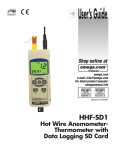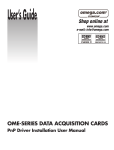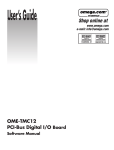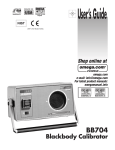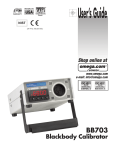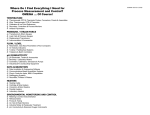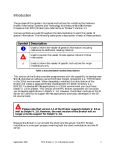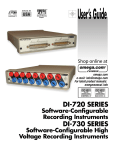Download io board user manual for calling dlls
Transcript
User’s Guide Shop online at www.omega.com e-mail: [email protected] OME-SERIES DATA ACQUISITION CARDS Calling DLLs User Manual OMEGAnet ® Online Service www.omega.com Internet e-mail [email protected] Servicing North America: USA: ISO 9001 Certified Canada: One Omega Drive, P.O. Box 4047 Stamford CT 06907-0047 TEL: (203) 359-1660 e-mail: [email protected] 976 Bergar Laval (Quebec) H7L 5A1, Canada TEL: (514) 856-6928 e-mail: [email protected] FAX: (203) 359-7700 FAX: (514) 856-6886 For immediate technical or application assistance: USA and Canada: Sales Service: 1-800-826-6342 / 1-800-TC-OMEGA® Customer Service: 1-800-622-2378 / 1-800-622-BEST® Engineering Service: 1-800-872-9436 / 1-800-USA-WHEN® TELEX: 996404 EASYLINK: 62968934 CABLE: OMEGA Mexico: En Español: (001) 203-359-7803 FAX: (001) 203-359-7807 e-mail: [email protected] [email protected] Servicing Europe: Benelux: Postbus 8034, 1180 LA Amstelveen, The Netherlands TEL: +31 (0)20 3472121 FAX: +31 (0)20 6434643 Toll Free in Benelux: 0800 0993344 e-mail: [email protected] Czech Republic: Frystatska 184, 733 01 Karviná, Czech Republic TEL: +420 (0)59 6311899 FAX: +420 (0)59 6311114 Toll Free: 0800-1-66342 e-mail: [email protected] France: 11, rue Jacques Cartier, 78280 Guyancourt, France TEL: +33 (0)1 61 37 29 00 FAX: +33 (0)1 30 57 54 27 Toll Free in France: 0800 466 342 e-mail: [email protected] Germany/Austria: Daimlerstrasse 26, D-75392 Deckenpfronn, Germany TEL: +49 (0)7056 9398-0 Toll Free in Germany: 0800 639 7678 e-mail: [email protected] United Kingdom: ISO 9002 Certified FAX: +49 (0)7056 9398-29 One Omega Drive, River Bend Technology Centre Northbank, Irlam, Manchester M44 5BD United Kingdom TEL: +44 (0)161 777 6611 FAX: +44 (0)161 777 6622 Toll Free in United Kingdom: 0800-488-488 e-mail: [email protected] It is the policy of OMEGA to comply with all worldwide safety and EMC/EMI regulations that apply. OMEGA is constantly pursuing certification of its products to the European New Approach Directives. OMEGA will add the CE mark to every appropriate device upon certification. The information contained in this document is believed to be correct, but OMEGA Engineering, Inc. accepts no liability for any errors it contains, and reserves the right to alter specifications without notice. WARNING: These products are not designed for use in, and should not be used for, patient-connected applications. Table of Contents 1. INTRODUCTION......................................................................................................................... 4 2. DECLARATION FILES .............................................................................................................. 5 3. LINKING....................................................................................................................................... 9 3.1 USING VISUAL C++................................................................................................................ 9 3.2 USING MFC ......................................................................................................................... 11 3.3 USING VISUAL BASIC ........................................................................................................... 14 3.4 USING DELPHI ...................................................................................................................... 16 3.5 USING BORLAND C++ BUILDER ........................................................................................... 17 3 1. Introduction The driver for the OME data acquisition products includes one or more DLL files (and VXD/SYS files) to be used by higher-level computer languages. The DLL files are written in Visual C++ and provide many functions to perform a variety of Analog input/output, Digital input/output, and Counter/Timer tasks with the OME hardware. The DLL files are in standard Win32 DLL format, and can be used with Windows 95/98/NT/2000/XP. With these functions, the user does not need to program the lower-level hardware controls. The DLL files can easily be integrated into programs written in higher-level computer languages. A large variety of demo programs written in Visual C++, Delphi, Borland C++ Builder and Visual Basic are provided. The DLL files provide powerful, easy-to-use subroutines for users to develop their data acquisition applications, Analog input/output, Digital input/output and RS232/RS-485 Communication applications. This manual describes how to call the DLL functions with Visual C++ 5.0, Visual Basic 5.0, Delphi 3.0 and Borland C++ Builder 3.0. The OME-PCI-TMC12 DAQ Card is used as an example. Before the using the DLL, the user must first install the software/driver. Please note the folder into which software is installed. This folder will contain all the drivers, demo programs and manuals. In addition, the DLL, VXD and SYS files will be copied into the following folders automatically when the user installs the software. DLL files Î C:\Windows\System\ (for Windows 95/98 user) Vxd files Î C:\Windows\System\ (for Windows 95/98 user) DLL files Î C:\WinNT\System32\ (for Windows NT/2000 user) Sys files Î C:\WinNT\System32\Drivers\ (for Windows NT/2000 user) The .SYS files need to be registered under Windows NT, thus if the user copies these files manually, they must refer to the file README.TXT for the software/driver to create the registry values. 4 2. Declaration Files In order to use the DLL functions, the declaration files for the programming language are required. The user can find these declaration files under the “driver” “folder. The DLL and declaration files for Windows 95/98, Windows NT and Windows 2000 are all different, so please exercise caution when choosing the files to incorporate into your program. For example: |--\TMC12 Win95 |--\Driver |--\BCB3 | |--\TMC12.H | |--\TMC12.LIB | |--\Delphi3 | |--\TMC12.PAS | |--\VB5 | |--\TMC12.BAS | |--\VC5 |--\TMC12.H |--\TMC12.LIB Æ Header file Æ Import Library Æ Declaration file Æ Declaration file Æ Header file Æ Import Library Note: The .LIB file is different between the BCB and VC. 5 Figure 2-1. The declaration file for Visual C++ 5.0. For example, the user would find the declaration files “TMC12.h” and “TMC12.Lib” for Visual C++ 5.0 in the folder: “C:\Program Files\DAS\TMC12 Win95\Driver\VC5” Note: The .Lib files are different for VC++ and BCB. Figure 2-2. The declaration file for Visual Basic 5.0. For example, the user would find the declaration file “TMC12.BAS” for Visual 6 Basic 5.0 in the folder: “C:\Program Files\DAS\TMC12 Win95\Driver\VB5” Figure 2-3. The declaration file for Delphi 3.0. For example, the user can find the declaration file “TMC12.PAS” for Delphi 3.0 in the folder: “C:\Program Files\DAS\TMC12 Win95\Driver\Delphi3” Figure 2-4. The declaration file for Borland C++ Builder 3.0. 7 For example, the user can find the declaration file “TMC12.H” and “TMC12.Lib” for Borland C++ Builder 3.0 in the folder: “C:\Program Files\DAS\TMC12 Win95\Driver\BCB3” Note: The .Lib files are different for VC++ and BCB. 8 3. Linking This chapter describes how to uses the declaration files with Visual Basic and Delphi. In addition, using the header file and importing libraries with Visual C++ and Borland C++ builder is also described. For more information about the DLL functions, please refer to the software manual (included with the Development-Toolkit). 3.1 Using Visual C++ Step 1: Execute the \MSDEV\BIN\VCVARS32.BAT to setup the environment. Step 2: Copy the declaration files into the user’s project folder. For example, declaration files: “TMC12.H” and “TMC12.Lib”. Note: The .H and .Lib files are different in VC++ and BCB. Step 3: The source program must include the declaration file. For example: #include “TMC12.H” Step 4: Edit the source program. (Refer to demo programs.) Step 5: Edit the MAKE file. (Refer to file XXX.mak for demo programs.) For example: demo1.exe : demo1.obj TMC12.lib link -SUBSYSTEM:windows -OUT:demo1.exe demo1.obj TMC12.lib -DEFAULTLIB:user32.lib gdi32.lib winmm.lib comdlg32.lib comctl32.lib Demo1.obj : demo1.c TMC12.h cl -c -DSTRICT -G3 -Ow -W3 -Zp -Tp demo1.c 9 Step 6: Uses NMAKE to make the user’s project. For example: NMAKE /f demo1.mak Step 7: End. NOTE: The Lib file is used at linking time and the DLL and Vxd are used at run time for Windows 95/98 (The DLL and Sys files for Windows NT). 10 3.2 Using MFC The key points are given below: Step 1: Use MFC wizard to create source code. Step 2: Copy the declaration files into the user’s project folder. For example, declaration files: “TMC12.H” and “TMC12.Lib”. Note: The .H and .Lib files are different in VC++ and BCB. Step 3: The source program must include the declaration file. For example: #include “TMC12.H” Step 4: Select the menu items “Project” / “Add To Project” / “Files…”. Refer to Figure 2-2-1. Figure 2-2-1. Select the menu items “Project” / “Add To Project” / “Files…”. Step 5: Select the declaration file to include. For example, “TMC12.h”. Refer to Figure 2-2-2. Step 6: Click the button “OK”. Refer to Figure 2-2-2. 11 Figure 2-2-2. Select the declaration file to include. 12 Step 7: Select the menu items “Project” / “Add To Project” / “Files…” again. Refer to Figure 2-2-3. Figure 2-2-3. Select the menu items “Project” / “Add To Project” / “Files…”. Step 8: Change the field “Files of type:” to “Library Files (.lib)”. Refer to Figure 2-2-4. Step 9: Select the library file to include. For example, “TMC12.lib”. Refer to Figure 2-2-4. Step 10: Click the button “OK”. Refer to Figure 2-2-4. Figure 2-2-4. Change the field “Files of type:” to “Library Files (.lib)”. Step 11: End. NOTE: The Lib file is used in linking time and the DLL and Vxd is used in run time for Windows 95/98 (The DLL and SYS files for Windows NT/2000). 13 3.3 Using Visual Basic Step 1: Copy the declaration file into the user’s project folder. For example, “TMC12.BAS”. Step 2: Select the menu items “Project” / “Add Module”. Refer to Figure 2-3-1. Figure 2-3-1. Select the menu items “Project” / “Add Module”. Step 3: Select the page “Existing”. Refer to Figure 2-3-2. Step 4: Select the declaration file to include. For example, the declaration file: “TMC12.BAS”. Refer to Figure 2-3-2. Step 5: Click the button “Open”. Refer to Figure 2-3-2. Figure 2-3-2. Select the declaration file to include. 14 Step 6: Check the project manager to verify that the module has been added successfully. Refer to Figure 2-3-3. Figure 2-3-3. Check if the module has been added into the project? Step 7: End. 15 3.4 Using Delphi Step 1: Copy the declaration file into the user’s project folder. For example, “TMC12.PAS”. Step 2: Include code in the user’s source program to use the declaration file. For example: Uses TMC12; Refer to Figure 2-4-1. Î include “TMC12.Pas” file Figure 2-4-1. To use the declaration file. Step 3: End. 16 3.5 Using Borland C++ Builder Step 1: Copy the declaration files into the user’s project folder. For example, declaration files: “TMC12.H” and “TMC12.Lib”. Note: The .H and .Lib files are different in VC++ and BCB. Step 2: The source program must include the declaration file. For example: #include “TMC12.H” Refer to Figure 2-5-1. Figure 2-5-1. Include the declaration file. Step 3: Select the menu items “Project” / “Add to Project…”. Refer to Figure 2-5-2. Figure 2-5-2. Select the menu items “Project” / “Add to Project…”. 17 Step 4: Change the field “Files of type:” to “Library file (*.lib)”. Refer to Figure 2-5-3. Step 5: Select the library to include. For example: “TMC12.Lib”. Refer to Figure 2-5-3. Step 6: Click the button “Open”. Refer to Figure 2-5-3. Figure 2-5-3. Select the library to include. Step 7: Select the menu items “View” / “Project Manager”. Refer to Figure 2-5-4. Figure 2-5-4. Select the menu items “View” / “Project Manager”. Step 8: Check the Project Manager to see if the library has been added into this project. Refer to Figure 2-5-5. Figure 2-5-5. Check if the library has been added into this project. Step 9: End. 18 WARRANTY/DISCLAIMER OMEGA ENGINEERING, INC. warrants this unit to be free of defects in materials and workmanship for a period of 13 months from date of purchase. OMEGA’s WARRANTY adds an additional one (1) month grace period to the normal one (1) year product warranty to cover handling and shipping time. This ensures that OMEGA’s customers receive maximum coverage on each product. If the unit malfunctions, it must be returned to the factory for evaluation. OMEGA’s Customer Service Department will issue an Authorized Return (AR) number immediately upon phone or written request. Upon examination by OMEGA, if the unit is found to be defective, it will be repaired or replaced at no charge. OMEGA’s WARRANTY does not apply to defects resulting from any action of the purchaser, including but not limited to mishandling, improper interfacing, operation outside of design limits, improper repair, or unauthorized modification. This WARRANTY is VOID if the unit shows evidence of having been tampered with or shows evidence of having been damaged as a result of excessive corrosion; or current, heat, moisture or vibration; improper specification; misapplication; misuse or other operating conditions outside of OMEGA’s control. Components which wear are not warranted, including but not limited to contact points, fuses, and triacs. OMEGA is pleased to offer suggestions on the use of its various products. However, OMEGA neither assumes responsibility for any omissions or errors nor assumes liability for any damages that result from the use of its products in accordance with information provided by OMEGA, either verbal or written. OMEGA warrants only that the parts manufactured by it will be as specified and free of defects. OMEGA MAKES NO OTHER WARRANTIES OR REPRESENTATIONS OF ANY KIND WHATSOEVER, EXPRESS OR IMPLIED, EXCEPT THAT OF TITLE, AND ALL IMPLIED WARRANTIES INCLUDING ANY WARRANTY OF MERCHANTABILITY AND FITNESS FOR A PARTICULAR PURPOSE ARE HEREBY DISCLAIMED. LIMITATION OF LIABILITY: The remedies of purchaser set forth herein are exclusive, and the total liability of OMEGA with respect to this order, whether based on contract, warranty, negligence, indemnification, strict liability or otherwise, shall not exceed the purchase price of the component upon which liability is based. In no event shall OMEGA be liable for consequential, incidental or special damages. CONDITIONS: Equipment sold by OMEGA is not intended to be used, nor shall it be used: (1) as a “Basic Component” under 10 CFR 21 (NRC), used in or with any nuclear installation or activity; or (2) in medical applications or used on humans. Should any Product(s) be used in or with any nuclear installation or activity, medical application, used on humans, or misused in any way, OMEGA assumes no responsibility as set forth in our basic WARRANTY/ DISCLAIMER language, and, additionally, purchaser will indemnify OMEGA and hold OMEGA harmless from any liability or damage whatsoever arising out of the use of the Product(s) in such a manner. RETURN REQUESTS/INQUIRIES Direct all warranty and repair requests/inquiries to the OMEGA Customer Service Department. BEFORE RETURNING ANY PRODUCT(S) TO OMEGA, PURCHASER MUST OBTAIN AN AUTHORIZED RETURN (AR) NUMBER FROM OMEGA’S CUSTOMER SERVICE DEPARTMENT (IN ORDER TO AVOID PROCESSING DELAYS). The assigned AR number should then be marked on the outside of the return package and on any correspondence. The purchaser is responsible for shipping charges, freight, insurance and proper packaging to prevent breakage in transit. FOR WARRANTY RETURNS, please have the following information available BEFORE contacting OMEGA: 1. Purchase Order number under which the product was PURCHASED, 2. Model and serial number of the product under warranty, and 3. Repair instructions and/or specific problems relative to the product. FOR NON-WARRANTY REPAIRS, consult OMEGA for current repair charges. Have the following information available BEFORE contacting OMEGA: 1. Purchase Order number to cover the COST of the repair, 2. Model and serial number of the product, and 3. Repair instructions and/or specific problems relative to the product. OMEGA’s policy is to make running changes, not model changes, whenever an improvement is possible. This affords our customers the latest in technology and engineering. OMEGA is a registered trademark of OMEGA ENGINEERING, INC. © Copyright 2002 OMEGA ENGINEERING, INC. All rights reserved. This document may not be copied, photocopied, reproduced, translated, or reduced to any electronic medium or machine-readable form, in whole or in part, without the prior written consent of OMEGA ENGINEERING, INC. Where Do I Find Everything I Need for Process Measurement and Control? OMEGA…Of Course! Shop online at www.omega.com TEMPERATURE Thermocouple, RTD & Thermistor Probes, Connectors, Panels & Assemblies Wire: Thermocouple, RTD & Thermistor Calibrators & Ice Point References Recorders, Controllers & Process Monitors Infrared Pyrometers PRESSURE, STRAIN AND FORCE Transducers & Strain Gages Load Cells & Pressure Gages Displacement Transducers Instrumentation & Accessories FLOW/LEVEL Rotameters, Gas Mass Flowmeters & Flow Computers Air Velocity Indicators Turbine/Paddlewheel Systems Totalizers & Batch Controllers pH/CONDUCTIVITY pH Electrodes, Testers & Accessories Benchtop/Laboratory Meters Controllers, Calibrators, Simulators & Pumps Industrial pH & Conductivity Equipment DATA ACQUISITION Data Acquisition & Engineering Software Communications-Based Acquisition Systems Plug-in Cards for Apple, IBM & Compatibles Datalogging Systems Recorders, Printers & Plotters HEATERS Heating Cable Cartridge & Strip Heaters Immersion & Band Heaters Flexible Heaters Laboratory Heaters ENVIRONMENTAL MONITORING AND CONTROL Metering & Control Instrumentation Refractometers Pumps & Tubing Air, Soil & Water Monitors Industrial Water & Wastewater Treatment pH, Conductivity & Dissolved Oxygen Instruments M3953/0403






















